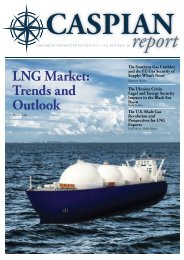Caspian Report - Issue: 07 - Spring 2014
You also want an ePaper? Increase the reach of your titles
YUMPU automatically turns print PDFs into web optimized ePapers that Google loves.
tion, with Saudi Arabia taking on the<br />
role of swing producer. The question<br />
is how long the Kingdom can sustain<br />
this role when faced with increasing<br />
demand at home and potential budget<br />
deficits. While Iraq has the potential<br />
to be a swing producer of the future,<br />
for the time being it seems the<br />
best course of action would be for<br />
both the major producers and consumers<br />
to come together to regulate<br />
supply and price.<br />
To protect themselves from fluctuating<br />
prices, members of the International<br />
Energy Agency and many<br />
other non-OPEC producers have<br />
been stockpiling energy reserves.<br />
Given the increased volatility in<br />
price witnessed between 2000 and<br />
2010 and the subsequent turmoil in<br />
Middle Eastern geopolitics, it seems<br />
sensible to call for market intervention<br />
with the goal of price stability.<br />
Working in concert, OPEC, the most<br />
powerful oil producers’ association,<br />
and the IEA, the largest energy consumers’<br />
organization, could achieve<br />
this. In June 2011, for example, the<br />
IEA released 60 million barrels of<br />
energy reserves in response to the<br />
disruption of oil supplies from Libya.<br />
However, greater cooperation is<br />
needed between the two organizations<br />
- together. Together, IEA and<br />
the OPEC have the capacity to devise<br />
a suitable intervention model in the<br />
common interest of price stability.<br />
Price stability would benefit the<br />
oil-dependent economies of OPEC<br />
and major African producers, stabilizing<br />
national incomes, supporting<br />
current government spending<br />
plans, and allowing states to plan<br />
for the future via the creation and<br />
expansion of wealth funds. International<br />
oil companies would be able<br />
to take a more secure view of their<br />
investments, supporting longerterm<br />
projects in infrastructure development<br />
and energy production. It<br />
would remove speculation from the<br />
market. A stable price of $100 per<br />
barrel would give certainty to the<br />
market and to world energy policies.<br />
Prices at this level would also have<br />
positive side-effects for the global<br />
energy regime: they would encourage<br />
the development of alternative<br />
energy sources such as wind and solar<br />
power, promote increased energy<br />
efficiency, and encourage major oil<br />
companies to invest in more efficient<br />
technologies and remoter locations.<br />
Contrary to popular wisdom, a lower<br />
oil price would only damage the economic<br />
prosperity of the U.S. and the<br />
major oil-producing nations, most<br />
of whom are developing nations<br />
acutely vulnerable to the damaging<br />
aspects of oil price volatility, which<br />
slowed their economic development<br />
to date. Critics might argue that such<br />
a high, stable price would slow down<br />
economic growth and recovery but<br />
in the long run it would do much to<br />
moderate the boom and bust aspects<br />
of the economic cycle, and reducing<br />
the risk to future, necessary capital<br />
investment. Building economic<br />
recovery on unrealistically cheap<br />
energy sets the system up for even<br />
greater failure when inevitable price<br />
shocks occur. What the global economy<br />
needs are stable, sustainable<br />
prices that can provide the basis for<br />
effective planning.<br />
109<br />
CASPIAN REPORT, SPRING <strong>2014</strong>










